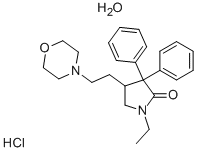7081-53-0

Product Name:
Doxapram hydrochloride monohydrate
Formula:
C24H30N2O2.ClH.H2O
Synonyms:
1-Ethyl-4-[2-(4-morpholinyl)ethyl]-3,3-diphenyl-2-pyrrolidinone monohydrochloride monohydrate;Doxapram hydrochloride monohydrate
Inquiry
SAFETY INFORMATION
| Signal word | Danger |
|---|---|
| Pictogram(s) |
 Skull and Crossbones Acute Toxicity GHS06 |
| GHS Hazard Statements |
H301:Acute toxicity,oral |
COMPUTED DESCRIPTORS
| Molecular Weight | 433.0 g/mol |
|---|---|
| Hydrogen Bond Donor Count | 2 |
| Hydrogen Bond Acceptor Count | 4 |
| Rotatable Bond Count | 6 |
| Exact Mass | 432.2179706 g/mol |
| Monoisotopic Mass | 432.2179706 g/mol |
| Topological Polar Surface Area | 33.8 Ų |
| Heavy Atom Count | 30 |
| Formal Charge | 0 |
| Complexity | 487 |
| Isotope Atom Count | 0 |
| Defined Atom Stereocenter Count | 0 |
| Undefined Atom Stereocenter Count | 1 |
| Defined Bond Stereocenter Count | 0 |
| Undefined Bond Stereocenter Count | 0 |
| Covalently-Bonded Unit Count | 3 |
| Compound Is Canonicalized | Yes |
PRODUCT INTRODUCTION
description
Doxapram Hydrochloride is a peripheral and central respiratory stimulant with a brief duration of action. Doxapram hydrochloride stimulates respiration by an action on chemoreceptors in the carotid arteries and, at increased dosage, stimulates central respiratory centers in the medulla as well as other parts of the brain and spinal cord. This results in an increased tidal volume and a slightly increased respiratory rate. Doxapram hydrochloride may also improve cardiac output probably due to an increased release of catecholamines. This respiratory stimulant is used in postanesthesia respiratory depression.